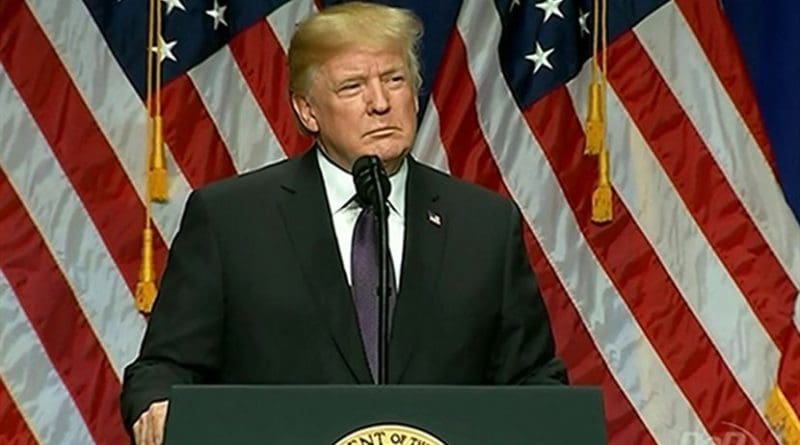Trump’s Presidency At A Pivot Point – OpEd
By Arab News
By Andrew Hammond*
At the end of a challenging 2017, Donald Trump enjoyed a modest bump to his presidential approval rating, which reached 38 percent, according to a Gallup poll — although it has since slipped back marginally amid the fallout from Michael Wolff’s controversial new book. With the Republican tax cut plan signed into law in December, Trump scored his first major legislative success and his presidency is now at a potentially decisive pivot point.
After his remarkable election victory in November 2016, big policy wins have been short on the ground for Trump. He enjoyed no presidential honeymoon last year, unlike many other incumbents of the past, despite the fact that the Republicans enjoyed a “clean sweep” of the November 2016 federal elections, securing majorities in both houses of Congress, as well as the White House.
A year into office, while Trump has shown himself to be an effective — if unorthodox — campaigner, it is still genuinely unclear what governing competence he will demonstrate as the first president since Dwight Eisenhower never before to have held elected office. Despite the billionaire businessman’s claims of being a master deal maker, repeated setbacks in 2017 underlined how different the national political domain can be to that of running a privately-held family conglomerate.
The presidency provides Trump with at least two broad powers: That of setting governing themes, and that of creating interactive coalitions among the public and within Congress in support of the administration’s legislative and wider programs.
Trump’s effectiveness in these two areas, which has been limited to date, will depend on his ability to exploit two sources of power: The popular prestige of the presidential office, and his leadership reputation among members of Congress and senior federal bureaucrats.
Strong, effective presidents exploit each source of power interactively, as for example Democrat Franklin Roosevelt and Republican Ronald Reagan did in the 1930s/40s and 1980s respectively. To make the presidency work most effectively, Trump will now have to show rapidly whether he knows how to do both.
Going forward, if Trump is to maximize his prospects of re-election in 2020, should he indeed run for a second term, he needs to demonstrate he is capable of developing a powerful and appealing governing agenda that has much more popular support. On the domestic front, it looks likely he will now try to build this around agendas like boosting infrastructure spending where there could well be majorities in Congress to cultivate in 2018.
On the foreign policy front, Trump can also potentially build popular support by showing greater coherence in his international policy after some significant confusion and apparent U-turns in 2017, including over Syria. He has big decisions to take in the coming weeks around issues like North Korea, and over key treaties like whether to preserve the North America Free Trade Agreement, and the nuclear deal with Iran where Trump has been praised by some domestic constituencies for being tough on Tehran while, for now at least, showing restraint.
Trump also needs to use less polarizing rhetoric and demonstrate greater reconciliation after the long, bitter election campaign in 2016. After a long period of such rancor, the country may be more divided than in living memory.
There have been only four previous occasions when a winning presidential candidate lost the popular vote, as Trump did in 2016: In 2000, when George W. Bush beat Al Gore; in 1888, when Benjamin Harrison bested Grover Cleveland; in 1876, when Rutherford Hayes overcame Samuel Tilden; and in 1824, when John Quincy Adams beat Andrew Jackson. The rarity of these electoral circumstances reinforces the need for Trump to strive for a healing of frayed relations, and establish strong governing themes for his presidency that command popular understanding and support whilst affording him latitude for political development and maneuver.
While there is still time for Trump to potentially turn around his presidency, the partisan animosity and wider political challenges now facing him means he is still on the back foot, despite the big Republican tax cut win in December.
Much of this is down to speculation surrounding the congressional and FBI investigations into his team’s alleged ties with Russia. This brewing scandal, which could yet become a full-blown crisis, has already claimed the scalp of national security adviser Michael Flynn, who in December pleaded guilty to lying to the FBI about conversations with Russia’s ambassador. It has also seen a former foreign policy adviser, George Papadopoulos, pleading guilty to perjury over his contacts with Russians linked to the Kremlin; as well as the president’s former campaign manager, Paul Manafort, facing charges of money laundering.
Taken overall, there is still time for Trump to succeed, despite the repeated setbacks of 2017. In suitably skilled hands, his office offers the potential for national renewal and unity in troubled times, and this remains true today. The next key test will be whether he has the skill and temperament to re-energize his administration, work more effectively with congressional colleagues, and forge a multi-year domestic policy governing agenda that can now bring the country closer together, rather than driving it further apart.
• Andrew Hammond is an associate at LSE IDEAS at the London School of Economics.

